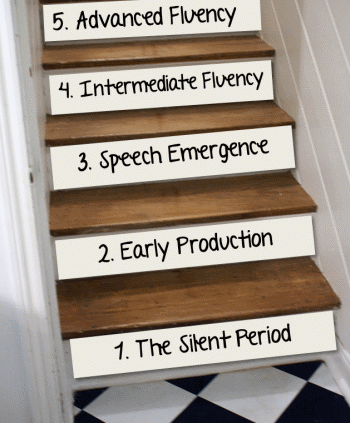Why You May Never Learn Another Language!
“Is it hard to learn another language? Which is the easiest language to learn? How long will it take to learn another language?”
These are questions I am constantly being asked by adults… adults who often regret the fact that they never mastered another language and, for that reason, are now motivated to give their children the opportunity to learn a second or a third language.
“I wish, I wish…. “ are most often the two words that come out of their mouths first. And if you look at the questions that adults ask, they are all attached to an OUTCOME. Most of us, as adults, like to know where we are going when we embark on a new journey. “Where will it end? Will I be successful? What will the outcome be? Will I be any good?”
For adults who are thinking of learning another language, here is a great infographic on learning expectations for many languages, based on the amount of time it takes a native English speaker to achieve speaking and reading proficiency.
The Serendipity of Untranslatable Words
Being a speaker of several languages, I often find a foreign word popping into one of my sentences when I am speaking English. Those of you who speak another language may support me in the fact that, just sometimes, there is a so much more succinct way of expressing something in another language, where English can only resort to a string of words. The problem is also that this ONE foreign word may also evoke a different emotional response, or transport the speaker back into another world, that the non-
An example contributed by our South African staff member today was the Afrikaans slang word “KNUIPING” which indicated the clenching of the buttocks when experiencing fear in order to avoid an untimely accident! Well, that got us laughing and thinking…speaker will simply not understand.
The 5 Stages of Second Language Acquisition
During childhood, the brain is more receptive to language learning than at any other time in a person’s life and starting foreign or second language learning early sets the stage for a child to develop advanced levels of proficiency in one or more languages. It is also increasingly being seen as a necessary 21st century skill set. Apart from the extensively researched and recognised cognitive benefits from learning one or more languages, doing so as a young child dramatically improves the development of a near-native pronunciation and language intonation.
More and more parents are accepting that knowledge of a language other than English (LOTE) can also enrich their child’s understanding and acceptance of other cultures, and the attendant future job opportunities it can bring in a world being brought ever closer together by increasing globalisation. So it’s no surprise that they are choosing to raise their child/ren as bilingual and/or give them the opportunity to learn a foreign language.
I Speak Dora
It is always refreshing to sit down on a mat with a group of enthusiastic pre-school children, their eyes wide, their minds open, ready to learn, ready to soak up new words and information, like little sponges.
I have been teaching languages to children, young and older people for about 25 years now. Teaching languages to pre-school children remains my favourite age group, simply because they are “little language learning machines”, eager to pick up new ways to communicate in new worlds that they are creating every day.
About two weeks ago, in Auckland, New Zealand, I had the great pleasure of conducting a language lesson for pre-schooler children and found myself sitting in front of about thirty pre-school children with some of my Mandarin-speaking colleagues. We were there to introduce a few French, Spanish, German and Chinese Mandarin songs and games to the kids. We began by gauging our audience and asked how many already spoke another language at home. The hands shot up and we were delighted by responses from a few bilingual Russian, Hindi, Arabic, Afrikaans, Korean and other Asian language-speaking children, keen to share greetings and expressions with us in their own native tongues.
Babelzone: Why LOTE teachers and Schools love our Language Learning Resource!
It is not easy to teach a second language and children can get easily bored with traditional teaching methods. This is what led LCF Clubs to create the global interactive language learning website which is helping to revolutionise how children learn. Read here about how it all began.
Babelzone is structured to suit all levels of language learning both in the LOTE classroom and at for children at home, who can use it as a place to have fun or as a learning tool to reinforce what they are learning in their Fun Language clubs.
In the LOTE classroom, Babelzone links seamlessly with both Le Club Français and El Club Español, the LCF Curricula and there are additional supporting teacher resources and student workbooks.
Ideal for use on Interactive Whiteboards or PCs, Babelzone engages by using catchy songs, games with an educational edge, stories to teach French or Spanish, MP3 files recorded by native speakers and printable activities to take anywhere. Interactivity and structure are the keys to this fantastic online language learning resource!
Read more: Babelzone: Why LOTE teachers and Schools love our Language Learning Resource!
That Foreign Language May Not Be As Foreign As You Think. Or Might It?
Our ability to form a limitless number of thoughts into a spoken word is what distinguishes the human species from our less evolved cousins but, while we know that language first appeared among Homo sapiens around 30 000 to 100 000 years ago, we still don’t know all the secrets of exactly HOW language evolved, or how the thousands of languages we have today have developed.
When you hear somebody speaking Polish and another person speaking Persian, they sound like totally different languages, don’t they? But listen more closely and you’ll hear similarities, like how one of the Persian words for mother is mada, and in Polish, it’s matka.
That’s because both languages belong to a large family known as the Indo-European languages. A group that contains over 400 languages and dialects: Polish, Persian, English, French, German, Russian, Icelandic. The list goes on.
But if you trace all those languages to their roots, exactly where and when did they come from? It’s a 200-year-old question and a topic of controversy.
Read more: That Foreign Language May Not Be As Foreign As You Think. Or Might It?






